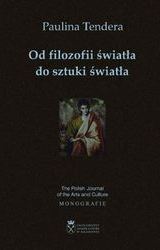
Paulina Tendera, From Philosophy of Light to The Art of Light [Od filozofii światła do sztuki światła], Jagiellonian University, The Polish Journal of the Arts and Culture (the Estetyka i Krytyka series) monographs, Kraków 2014.
In this book I have presented the philosophy of light as one of the aspects of the general process of development of reality which can be expressed in the form of a dialectic diagram: the ancient philosophy of light – the medieval philosophy of light – the Romantic philosophy of light. More specifically, the ancient philosophy of light stands in opposition to the Christian philosophy (theology of light) which represents a new subjective consciousness. One of the elements of this consciousness is the ethical ideal which places suffering, sacrifice and martyrdom over the ethos of a Homeric hero (Hegelian "beautiful individuality"). The Romantic period created the cult of a God-man, dying on the cross, which stands in clear opposition to the Greek notion of kalos kagathos. However, Christianity still retains and cultivates the Platonic tradition. Although Christian philosophy in its early centuries is de facto a mere theology, which only projects an aspectual image of Reason, it has some strong support in sacred art which is the first form of the Romantic art of light. Sacred art constitutes the sensual side of faith, expressing the Absolute in an illustrative, imperfect and simplified way. The Christian religion then eliminates this sensual and illustrative character through religious reformation and once again relates back to philosophy, thus resulting in the acquisition of a final and complete knowledge of mankind, beside which only secular art is created. Although the way of thinking presented here does not deny the possibility of retelling the story of the history of light in a completely different manner, it allows for the substantiation of its argumentation in accordance with the Hegelian tradition of philosophy of history: if the specific aspects of claritas reveal themselves throughout history as philosophical theses, theological treatises or works of art, then the relation between them must have a processual, purposeful, dialectical and rational character. This statement forms the basis of any attempt to describe the history of claritas by means of the philosophy of history. This work is intended to be an attempt to tell the history of claritas, as well as to evaluate its meaning from the point of view of the philosophy of history.
Key-words: art, philosophy of light, art of light, metaphysics of light, Hegel, Platon
The full text can be accessed there; for an English summary see pp. 233-238.

